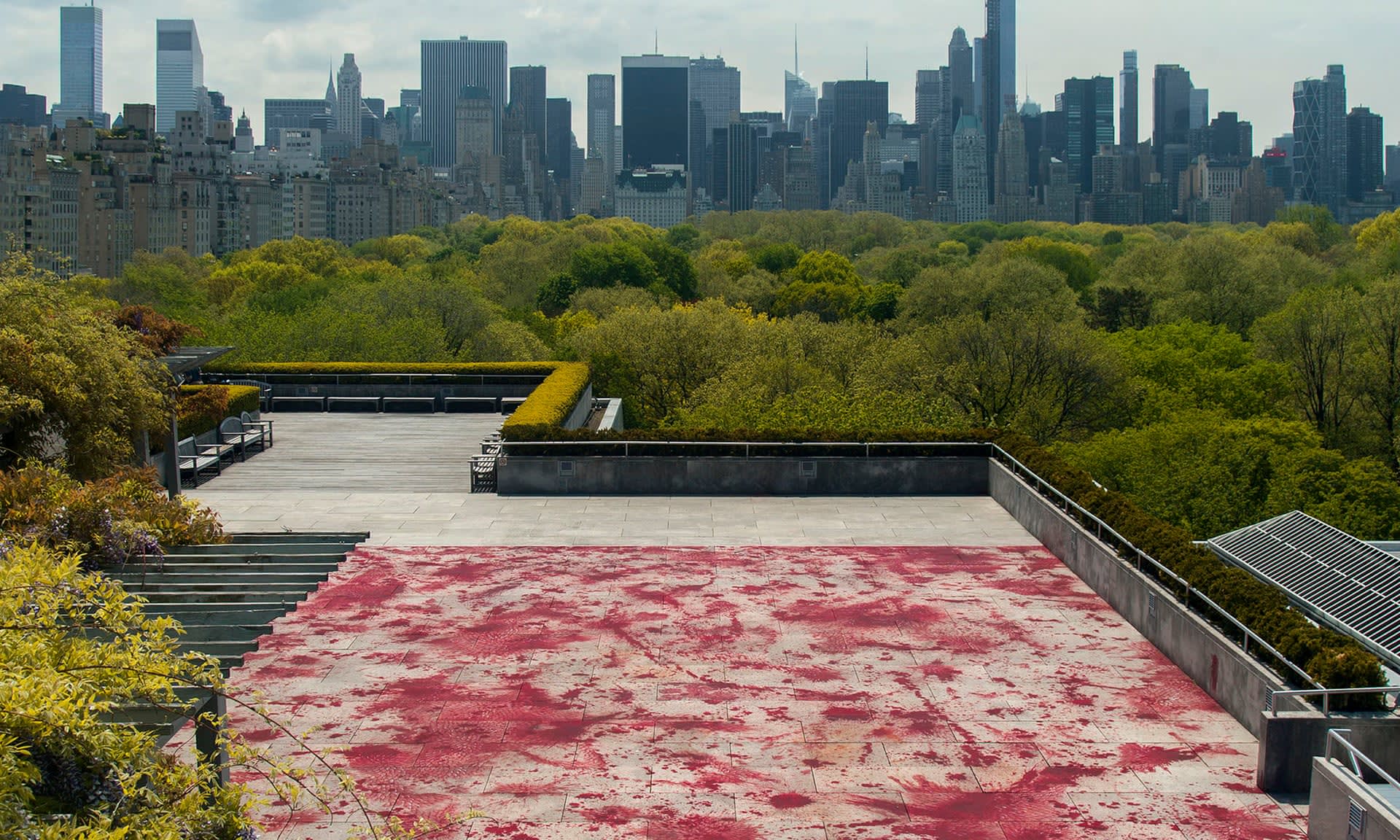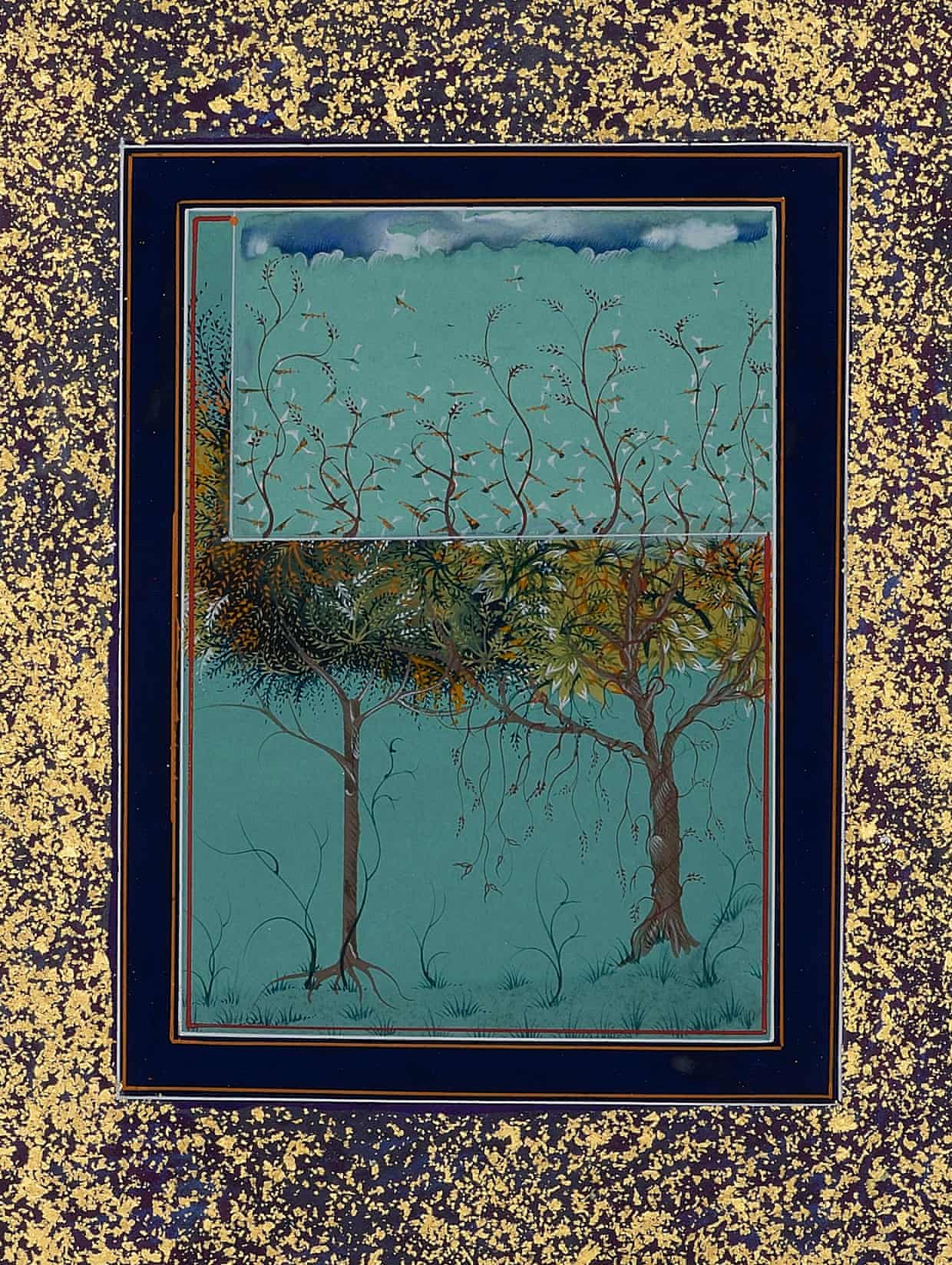
'Violence is all around me': Imran Qureshi on his disturbing miniatures

Mughal masters began painting miniatures five centuries ago. Now Imran Qureshi has taken up the same squirrel-hair brush as those before him – but his tiny trees are filled with splashes of blood and violence
Imran Qureshi has been up since 4am. His forthcoming show, Where the Shadows Are So Deep, is a collection of 35 exquisitely detailed miniature paintings, and he still has “four or five” to finish off. The show opens in seven days.
The magnitude of his task was something that curator Eleanor Nairne, who calls the exhibition an “epic distillation of labour”, was worried about from the outset. “I thought about how many pieces there were, worked out timings, and called his gallery: is this really going to be possible?” That was early in 2015. The artist, who lives in Lahore, Pakistan, says he started painting only in November.
All this is remarkable because of the tradition Qureshi is working in: miniatures produced using the techniques of 16th-century Mughal masters. Every aspect of the process is painstaking. Even the paper is handmade, multiple layers glued together to create a ground known as wasli. (“It comes from the word wasil, which means the moment when you meet your beloved,” he tells me.) The works themselves speak of hours bent over an easel, executing tiny strokes with the customary squirrel-hair brush. Leaves and dragonflies are millimetres long, the tiny features of a self-portrait remarkably vivid. And then there are the more violent flourishes that have become Qureshi’s trademark: splotches of blood-red pigment and chaotic streaks of blue that invade otherwise serene compositions.
We sit at the end of the Curve, the echoing concrete gallery at the Barbican, London, in which the paintings will be hung – for the moment they are represented by print-outs taped to the wall, tiny in the vastness of the space. Qureshi, who grew up in Hyderabad, Sindh province, is padded out against the chilly London weather in a fleece and gilet. His voice is soft but deliberate. It’s a quality evident in his pictures, which somehow manage to convey delicacy and hardness at the same time.
He says he enjoys the sense of surprise when the viewer, anticipating something “exotic or decorative or jewel-like”, is confronted by scenes that are “more disturbing”. In one diptych, a blood-spattered tree leans towards another in the adjacent frame. Its trunk has snapped. “The trees are like characters. This one is the romantic: it inclines towards another but in doing so loses its own roots.”
In other work, Qureshi has deployed the trick in reverse. For a commission at the Metropolitan Museum of Art in New York in 2013, he covered the roof terrace with what looked like splashes of blood, evoking the carnage following a terrorist attack – a bold statement a month after the Boston marathon bombings. On closer inspection, the pools of red, overlaid with an intricate network of stylised leaves, could be interpreted as blossoms. “There’s the idea of life, beauty and death working together,” he says. “There is an element of violence in the work. At the same time, when you come close to it and start looking at it carefully, it becomes poetic as well.”
This darkness is a reflection of the political context in which Qureshi finds himself, but the message is universal. “Generally, there’s a lot of violence around me in Pakistan, but then there is a lot of violence all over the world. Violence is not a strange thing or a stranger for anyone.”
Qureshi’s output is by no means limited to Mughal-style painting: he has produced installations, videos, even pop promos. But his mastery of the discipline is extraordinary from the point of view of western art. You’d imagine European painters capable of emulating old masters might go into forgery rather than contemporary art. In Pakistan, the National College of Arts in Lahore kept the tradition of miniature painting alive. Now a number of NCA-trained artists, including Shazia Sikander and Qureshi’s wife Aisha Khalid, use the medium in groundbreaking ways.
A freshman at the NCA in the early 90s, Qureshi at first avoided it. “I was enjoying landscape painting, mixed media, the playfulness and the freedom of different materials. I thought: this is not for me.” Eventually, one professor, Bashir Ahmed, persuaded him to give it a try. It was labour-intensive, and involved the endless copying of classic works. “We were supposed to be there at 8.30 or 9am every day and then I was going back at 10, 11, 12pm to my hostel. My other friends said, ‘You should not go there; you will always be copying.’ But the idea is to master the technique. And then slowly they asked us to do our own things using whatever we had learned.”
Don’t the strictures and rules of miniature painting inhibit him? Isn’t the whole thing a bit outmoded? “I think it’s just a medium. And for me, it’s like I’m talking in my mother tongue, instead of talking in a foreign language. I’m so comfortable with it.” And though the tradition grew out of Muslim princely courts, the depiction of living beings and even erotic themes have long been part of the miniaturist’s repertoire. “There are all kinds of very bold subjects in old miniatures. They are there. So I never feel any of kind of boundary.”
Despite the violence that finds its way into much of his work – the series of bombings that hit Lahore in March 2010 was a turning point for him – Qureshi is hopeful about the future in Pakistan, where he and Aisha are raising two sons. “We always see a bad face of Pakistan through the media. But there are a lot of good things happening over there which we don’t see. And that’s why I am still living there. Everybody gets surprised that I am still living there. But I always prefer to. It’s my country. It gives me another kind of strength and support when I am actually in my own land. That is the reason that the work also has that kind of feel in it, that strength,” he says.
It’s getting late, and like generations of artists before him, Qureshi has some miniatures to finish. “I will do it in the apartment,” he smiles, with an air that conveys both confidence and a hint of panic. “I will do it.”
• Imran Qureshi: Where the Shadows Are So Deep, is at the Barbican, London, 18 February-10 July.

Threatened, 2014, by Imran Qureshi.

Rise and Fall, 2014, by Imran Qureshi.

Qureshi at work on paintings for his exhibition Where the Shadows Are So Deep. Photograph: Awais Gohar

Imran Qureshi. Photograph: Tiziana Fabi/AFP/Getty Images